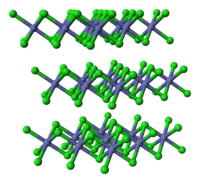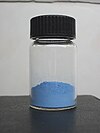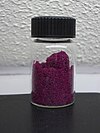Cobalt(II) chloride
|
|||
 Structure of anhydrous compound
|
|||
 Structure of hexahydrate
|
|||
| Names | |||
|---|---|---|---|
|
IUPAC name
Cobalt(II) chloride
|
|||
| Other names
Cobaltous chloride
Cobalt dichloride Muriate of cobalt |
|||
| Identifiers | |||
|
7646-79-9 16544-92-6 (dihydrate) 7791-13-1 (hexahydrate) |
|||
| 3D model (Jmol) | Interactive image | ||
| ChEBI |
CHEBI:35696 |
||
| ChemSpider |
22708 |
||
| ECHA InfoCard | 100.028.718 | ||
| EC Number | 231-589-4 | ||
| PubChem | 3032536 | ||
| RTECS number | GF9800000 | ||
| UNII |
EVS87XF13W |
||
| UN number | 3288 | ||
|
|||
|
|||
| Properties | |||
| CoCl2 | |||
| Molar mass | 129.839 g/mol (anhydrous) 165.87 g/mol (dihydrate) 237.93 g/mol (hexahydrate) |
||
| Appearance | blue crystals (anhydrous) violet-blue (dihydrate) rose red crystals (hexahydrate) |
||
| Density | 3.356 g/cm3 (anhydrous) 2.477 g/cm3 (dihydrate) 1.924 g/cm3 (hexahydrate) |
||
| Melting point | 735 °C (1,355 °F; 1,008 K) (anhydrous) 140 °C (monohydrate) 100 °C (dihydrate) 86 °C (hexahydrate) |
||
| Boiling point | 1,049 °C (1,920 °F; 1,322 K) | ||
| 43.6 g/100 mL (0 °C) 45 g/100 mL (7 °C) 52.9 g/100 mL (20 °C) 105 g/100 mL (96 °C) |
|||
| Solubility | 38.5 g/100 mL (methanol) 8.6 g/100 mL (acetone) soluble in ethanol, ether, pyridine, glycerol |
||
| +12,660·10−6 cm3/mol | |||
| Structure | |||
| CdCl2 structure | |||
| hexagonal (anhydrous) monoclinic (dihydrate) Octahedral (hexahydrate) |
|||
| Hazards | |||
| Safety data sheet | ICSC 0783 | ||
|
EU classification (DSD)
|
Toxic (T) Carc. Cat. 2 Dangerous for the environment (N) |
||
| R-phrases | R49, R60, R22, R42/43, R68, R50/53 | ||
| S-phrases | S53, S45, S60, S61 | ||
| NFPA 704 | |||
| Flash point | Non-flammable | ||
| Lethal dose or concentration (LD, LC): | |||
|
LD50 (median dose)
|
80 mg/kg (rat, oral) | ||
| Related compounds | |||
|
Other anions
|
Cobalt(II) fluoride Cobalt(II) bromide Cobalt(II) iodide |
||
|
Other cations
|
Rhodium(III) chloride Iridium(III) chloride |
||
|
Except where otherwise noted, data are given for materials in their standard state (at 25 °C [77 °F], 100 kPa).
|
|||
|
|
|||
| Infobox references | |||
Cobalt(II) chloride is an inorganic compound of cobalt and chlorine, with the formula CoCl2. It is usually supplied as the hexahydrate CoCl2·6H2O, which is one of the most commonly used cobalt compounds in the lab.
The hexahydrate is purple, whereas the anhydrous form is sky blue. Because of the ease of the hydration/dehydration reaction, and the resulting color change, cobalt chloride is used as an indicator for water in desiccants.
Niche uses of cobalt chloride include its role in organic synthesis and electroplating objects with cobalt metal.
Cobalt chloride has been classified as a substance of very high concern by the European Chemicals Agency as it is a suspected carcinogen.
Aqueous solutions of both CoCl2 and the hydrate contain the species [Co(H2O)6]2+. They also contain chloride ions. In the solid state CoCl2·6H2O consists of the molecule trans-[CoCl2(H2O)4] and two molecules of water of crystallization. This species dissolves readily in water and alcohol. Concentrated aqueous solutions are red at room temperature but become blue at higher temperatures. CoCl2·6H2O is deliquescent, and the anhydrous salt CoCl2 is hygroscopic, readily converting to the hydrate.
Hydrated cobalt chloride is prepared from cobalt(II) hydroxide or cobalt(II) carbonate and hydrochloric acid:
...
Wikipedia



